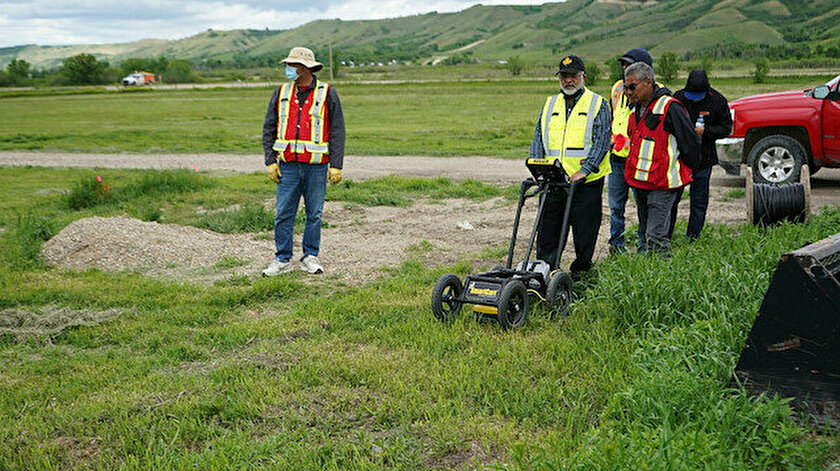A Canadian Indigenous group said in a statement on Wednesday that a search using ground-penetrating radar has found 182 human remains in unmarked graves at a site near a former Catholic Church-run residential school that housed Indigenous children taken from their families.
The latest discovery of graves near Cranbrook, British Columbia follows reports of similar findings at two other such church-run schools, one of more than 750 unmarked graves and another of 215 bodies. Cranbrook is 524 miles (843 kilometers) east of Vancouver.
The Lower Kootenay Band said in a news release that it began using the technology last year to search the site close to the former St. Eugene’s Mission School, which was operated by the Catholic Church from 1912 until the early 1970s. It said the search found the remains in unmarked graves, some about 3 feet (a meter) deep.
It’s believed the remains are those of people from the bands of the Ktunaxa nation, which includes the Lower Kootenay Band, and other neighboring First Nation communities.
Chief Jason Louie of the Lower Kootenay Band, which is also a member of the Ktunaxa Nation, called the discovery “deeply personal” since he had relatives attend the school.
“Let’s call this for what it is,” Louie told CBC radio in an interview. “It’s a mass murder of Indigenous people.”
“The Nazis were held accountable for their war crimes. I see no difference in locating the priests and nuns and the brothers who are responsible for this mass murder to be held accountable for their part in this attempt of genocide of an Indigenous people.”
From the 19th century until the 1970s, more than 150,000 Indigenous children were forced to attend state-funded Christian boarding schools in an effort to assimilate them into Canadian society. Thousands of children died there of disease and other causes, with many never returned to their families.
Nearly three-quarters of the 130 residential schools were run by Roman Catholic missionary congregations, with others operated by the Presbyterian, Anglican and the United Church of Canada, which today is the largest Protestant denomination in the country.
The Canadian government has acknowledged that physical and sexual abuse was rampant in the schools, with students beaten for speaking their native languages.
Last week the Cowessess First Nation, located about 85 miles (135 kilometers) east of the Saskatchewan capital of Regina, said investigators found “at least 600” unmarked graves at the site of a former Marieval Indian Residential School.
Last month, the remains of 215 children, some as young as 3 years old, were found buried on the site of what was once Canada’s largest Indigenous residential school near Kamloops, British Columbia.
Prior to news of the most recent finding, Canadian Prime Minister Justin Trudeau said he has asked that the national flag on the Peace Tower remain at half-mast for Canada Day on Thursday to honor the Indigenous children who died in residential schools.
On Tuesday, it was announced that a group of Indigenous leaders will visit the Vatican later this year to press for a papal apology for the Roman Catholic Church’s role in residential schools.
The Canadian Conference of Catholic Bishops said Indigenous leaders will visit the Vatican between Dec. 17 and 20 to meet with Pope Francis and “foster meaningful encounters of dialogue and healing.”
After the graves were found in Kamloops, the pope expressed his pain over the discovery and pressed religious and political authorities to shed light on “this sad affair.” But he didn’t offer the apology sought by First Nations and the Canadian government.
Louie said he wants more concrete action than apologies.
“I’m really done with the government and churches saying they are sorry,” he said. “Justice delayed is justice denied.”
The Canadian government formally apologized for the policy and abuses in 2008. In addition, the Presbyterian, Anglican and United churches have apologized for their roles in the abuse.
A papal apology was one of 94 recommendations from Canada’s Truth and Reconciliation Commission, but the Canadian bishops conference said in 2018 that the pope could not personally apologize for the residential schools.
Since the discovery of unmarked graves at the sites of former residential schools, there have been several fires at churches across Canada. There has also been some vandalism targeting churches and statues in cities.
Four small Catholic churches on Indigenous lands in rural southern British Columbia have been destroyed by suspicious fires and a vacant former Anglican church in northwestern B.C. was recently damaged in what RCMP said could be arson.
On Wednesday, Alberta’s premier condemned what he calls “arson attacks at Christian churches” after a historic parish was destroyed in a fire.
“Today in Morinville, l’église de Saint-Jean-Baptiste was destroyed in what appears to have been a criminal act of arson,” Kenney said in a statement.
RCMP said officers were called to the suspicious blaze at St. John Baptiste Parish in Morinville, about 40 kilometers north of Edmonton, in the early hours of Wednesday.
